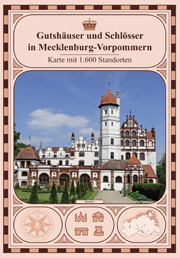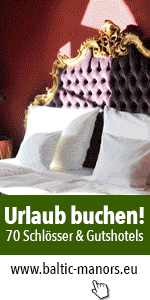Deutsche Website
Map of manor house locations in Mecklenburg

On the map you will find approx. 1600 locations of manor houses, manor houses, castles and palaces.
Order form
Book "Manor houses and castles in Western Pomerania"

In Volume 3, we present 49 estates on 151 pages with short texts and more than 220 historical and current photographs.
So that your dream does not become a nightmare

A real estate portal dedicated to castles and manor houses in Mecklenburg-Vorpommern and Brandenburg that supports you in every phase of your project's development.
Manor House Alt Guthendorf
“Guthendorp” was first documented in 1210. Duke Albert von Mecklenburg pledged the cities and castles of Marlow and Sülze as well as 23 other places to the Bishop of Schwerin on 13 January 1371.
The noblemen Kurt and Joachim von Zeppelin were named as the Alt-Guthendorf village owners in 1576. By the way, the airship builder Zeppelin is related to the Mecklenburg Zeppelin. The Zeppelin family resided for almost 300 years in Alt-Guthendorf, and then the estate was sold to the Ribnitz convent. Mr. von Hoben was the tenant of the estate for the convent.
Christian Ernst Friedrich von Vogelsang had the village tenancies from 1794. Christian Ernst Friedrich von Vogelsang was a leading personality of the Mecklenburg knights. He held the Knight’s Office in North-East Mecklenburg. He had to e.g. help in the organisation of the great advance made by Napoleon’s troops against Russia in 1813 as part of this position. Christian Ernst Friedrich von Vogelsang died in 1821.The story of a hidden treasure is entwined around his grave. This came about as a result of the extensive inscription on his grave slab. This is meant to decree that it is not to be touched for 100 years which, with the circumstance that he was childless, created the legend about the treasure. The inscription has been respected. Despite all the graves in the church being levelled, the grave slab had been preserved until the mid-80s last century. The estate, after the death of Christian Ernst Friedrich von Vogelsang, went to his brother, Gustav Casimir Hardenatz von Vogelsang, who died in 1848.
The estate changed tenants after that, the last squires being the Winter family. The Alt-Guthendorf manor house was first settled by refugees after 1945 and then divided up in the land reform. It was a residence for several families in DDR times. The middle section housed the shop, and the cultural room for the village was in the left wing. Two great brick stables, built at the turn of the century, and a barn with two doors also belonged to the estate. The barn with two doors is still completely preserved. There is only one stable which is being renovated, the other one was demolished in 1999. It is estimated that the manor house dates from the 17th century, although the exact building year cannot be found. A fire insurance document made in 1799 describes the house in its present form. It is known for certain that the wings were added later. The house itself is thus at least 100 years older. The building was made as a half-timbered building from oak and larch. The foundations are made of stones cut on one side, and the average thickness (determined in the cellar area) is one metre. Door reveals and cellar windows consist of bricks in the baroque format. The outer wall panels are made with handmade and set bricks in a 28 x 7 x 14 format. The outer wall in the main house between both wings was replaced with brickwork at an indeterminable time. It was also probably moved outwards too as the main house is wider here than in the rest of the building parts. The inner wall panels are made with adobe. The building’s roof structure is clearly made of two types of rafters. Firstly the carved oak beams with a rafter distance of 1.60 m in addition with pine rafters in between with a smaller diameter which have been sawn. This is a clear indicator that the roof must have been covered earlier with straw or reeds, as there is only this type of distance between the rafters due to the low weight. The other rafters were probably set between the originals to avoid the roof buckling when covered again with plain claystone tiles. The roof structures of the wings are made of carved pine rafters. There are several small pointed dormer windows and bat dormer windows on the roof as well as a larger avant-corps from the 20s over the entrance which is flanked by two supporting dormer windows.
Further details in the house such as the stair design, the window shapes in the main building and the interior design date from the rebuilding in the 1920s.
The manor house renovation was finished in 2011.
Structure of ownership prior to 1945:
| 1690 until after 1764 |
von Hobe |
| 1704 |
Johann Friedrich von Hobe |
| 1780-1786 |
Hans Adam von Kalden (Kahlden) |
| 1786-1794 |
Captain Detlov von Bilow (Bilau) |
| 1794-1821 |
Lieutenant Christian Ernst Friedrich von Vogelsang |
| 1821-1848 |
Major Gustav Casimir Hardenar von Vogelsang |
| 1848-1860 |
The Brothers von Vogelsang |
| 1860-1861 |
Chamberlain Karl H. L. von Vogelsang |
| 1861-1885 |
Ernst Christoph Adolf Friedrich von Lowtzow |
| 1885-1903 |
Wilhelm von Lowtzow |
| 1903-(1938) |
Publisher Otto Winter (Heidelberg) |
| -1945 |
Winter Family |
Gutshaus Alt Guthendorf
18337 Alt Guthendorf, Am Park 11
Contact:
Carola Topp
Phone:
038221-42398 oder 0170-2980790
Email:
agd11SPAMFILTER@gmx.de
Url: www.gutshof-alt-guthendorf.de















